Dogs chase their own tails, monkeys shimmy up trees, and squirrels rouse each other in games of tag. Children jump, wiggle and dance just to feel their bodies move. Mammals — from the simplest to the most intelligent species — have a natural disposition to play.
Contrast these images with the typical American gym-goer, hovering around the bench press, waiting his turn to hoist a barbell above his chest, and it’s no wonder we’ve adopted the word “workout” to describe exercise.
What if our next trip to the gym was not a forced regimen of rigid, linear movements, but rather a playful, dynamic dance that engaged body, mind and spirit? This is the vision of fitness educator Frank Forencich and his Seattle-based Exuberant Animal organization. Forencich believes exercise should come naturally to us. His philosophy is based on three interconnected principles: primal, practical and playful. (See “Wild Workouts” for more on primitive exercise.)
The movements Forencich incorporates in his programs encourage participants to be in a play state. “It’s not for some external reward; you’re doing it because you love to do it. You’re feeling immensely creative and unselfconscious,” he says.
Forencich designed the following full-body circuit workout so you can take the Exuberant Animal principles to the gym. It’s chock-full of moves that simulate real-world challenges, encourage a joyful frame of mind and keep you guessing about what you’ll do next. Each exercise demands strength, flexibility, focus and endurance, all of which are essential for helping you stay mobile well into old age.
“The idea is that it makes more sense to emphasize quality of movement over appearance. If you take this approach, your body will become faster, stronger and smarter,” Forencich says.
Yes, smarter — because when your muscles have to “think” about what they are doing next, they can better react and adapt to new situations.
To give your body and mind a fresh challenge, try substituting this workout for a strength-training session once a week. When you feel comfortable performing the exercises, develop your own Exuberant Animal–style moves and incorporate them into your routine.
The Warm-Up
The goal of the warm-up is to rev up your muscular and cardiovascular systems while adopting a playful, uninhibited mindset. “How did you feel when you were 8 years old, running around on the playground?” asks Forencich. Bring that exuberance to the following exercises.
No-Rope Jump Rope
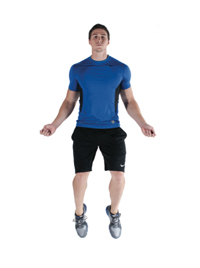
What it does: Wakes up the cardiovascular, muscular and nervous systems.
How to do it:
- Pick up your imaginary handles and begin jumping rhythmically, as if you are really jumping rope.
- Strive to land lightly on the balls of your feet, and pay attention to how your feet, ankles, legs and hips contribute to the movement.
- Continue for 60 seconds, or more if you’re game.
Imagine this: You’re a champion boxer in perfect condition. Your feet are agile, light and adaptable.
What to watch for: Minimize the noise you make as your feet hit the ground.
Imaginary Hula Hoop

What it does: Mobilizes hip joints and increases awareness of the connection between your core and hips.
How to do it:
- Just as you would with a real Hula-Hoop, move your hips in a circular pattern, keeping your upper torso still.
- For a challenge, try this on one foot or one-and-a-half feet (balance your weight on one foot, but keep the other foot touching the ground for support).
- Continue for 60 seconds, or more if you’re game.
Imagine this: You’re wearing a belt with a paintbrush strapped on to it and you’re trying to draw circles (of all sizes, in both directions) with that brush.
What to watch for: Try to keep your weight evenly distributed on your feet.
Arrow Draw

What it does: Activates the muscles of your upper back, core and shoulders.
How to do it:
- Step one foot out about an arm’s length in front of the other.
- Turn the back foot to point outward.
- Keep your weight on your back foot and use your core and upper back to draw back the string on your imaginary bow.
- Exhale deeply for five to 15 seconds as you pull back as far as you can.
- Slowly return to the starting position and repeat.
- Continue until you’ve done at least six reps per side.
Imagine this: You’re a hero from Greek mythology, a powerful warrior working with a very demanding bow.
What to watch for: Keep your knees slightly bent and your abdominal muscles engaged.
The Workout
Equipment
- 8- to 15-pound medicine ball
- Swiss ball
- Two to six 6- to 12-inch hurdles or other objects that can be used as hurdles
- Two 5- to 10-pound dumbbells (optional)
- Timer or watch (optional)
- A vivid imagination
These exercises are done in supersets. This means you’ll alternate between the exercises in each pairing, without resting, until you’ve completed three sets of each.
1. How the Wild Things Move Crawl in Place

What it does: Improves integration of the upper and lower body, and builds core strength and shoulder stability.
How to do it:
- Starting from a squat position, lower your hands to the ground and walk them out in front of you as far as you feel is comfortable.
- Lift opposite arm and leg together about 3 inches off the ground, alternating sides.
- Start with small, quick lifts and progress to higher, slower lifts.
- Continue for 30 seconds to two minutes.
Make it harder: Extend hands out farther in front and lower your torso until you begin from a plank position.
Imagine this: As a hunter, you want to limit your exposure so you are hiding behind the bushes to keep a low profile.
What to watch for: Keep your lifts controlled and try not to let your hips and torso tilt toward one side as you lift your limbs.
Monster Walk
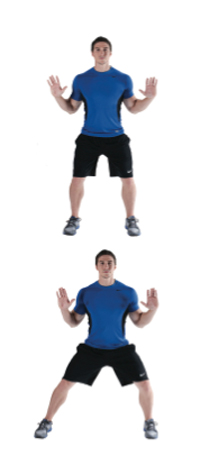
What it does: Strengthens the muscles that stabilize your hips.
How to do it:
- Stand with your feet a few inches wider than your hips (or as wide as is comfortable) and bend your knees slightly, maintaining a vertical upper body.
- Maintaining this wide stance and keeping feet from crossing over one another, begin shuffling laterally
- Switch directions: Move forward, backward and diagonally.
- Perform for one to two minutes.
Make it harder: Tie a resistance band around your ankles and keep tension on the band as you move.
Imagine this: You’re in a field of rocks and you have to pick up your feet to get over the obstacles.
What to watch for: Maintain a wide stance and lead the movement with your hips, not with your feet or shoulders.
2. On the Ball Backstroke
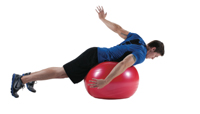
What it does: Improves scapular mobility and strengthens spinal erectors.
How to do it:
- Lie facedown on a Swiss ball with your head, neck and shoulders extended forward over the ball. (Your toes should be on the ground and can be propped against a wall for support.)
- Begin circling your arms backward, maintaining your position over the ball
- Continue for one to two minutes.
Make it harder: Slide farther forward off the ball, keeping your spine engaged.
Imagine this: You’re underwater and free to move your arms and shoulders luxuriously: small circles or big; alternating or together; slow or fast.
What to watch for: If you experience shoulder discomfort, avoid full range of motion and stick to smaller arm circles.
3. Diagonal Reach
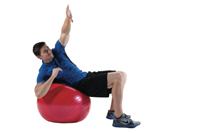
What it does: Integrates core and upper body from the obliques to the shoulders.
How to do it:
- Lie on your back over a Swiss ball so that the small of your back rests on the ball.
- Keep your shoulders, head and neck in a straight line, extended off the ball. Feet should be hip-width apart.
- Reach one arm up and over, diagonally across your body, trying to get shoulder blades as high off the ball as possible. Alternate arms.
- Perform for 30 seconds to one minute.
Make it harder: Hold a 5- to 10-pound dumbbell in each hand.
Imagine this: “You’re a boxer and your coach is holding targets for you to strike,” says Forencich. ”He gives you a variety of distances and angles to work with.”
What to watch for: Keep the Swiss ball from moving.
4. Last Dance Lateral Hurdle Crossing

What it does: Improves lateral mobility and peripheral vision.
How to do it:
- Place two cones 20 to 30 feet apart.
- Between the cones, position two to four low hurdles at random distances apart.
- Start at one cone and quickly side shuffle to the other, leaping over the hurdles in your path. Return to the first cone.
- Repeat for one minute.
Make it harder: Use more or taller hurdles.
Imagine this: Think of yourself as a professional football player doing drills.
What to watch for: Keep eyes straight ahead. Keep feet aligned and pointing forward.
5. Medicine Ball Figure Eights
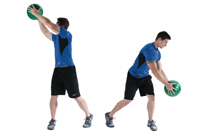
What it does: Improves communication between upper and lower body, activates the core, and improves shoulder mobility.
How to do it:
- Hold an 8- to 15-pound medicine ball and move it in figure eights, varying the size of your loops from small to enormous.
- Perform for one minute.
Make it harder: Perform in a lunge, monster stance or on one foot.
Imagine this: You are holding a ball of light or energy — keep it flowing.
What to watch for: Keep knees slightly bent, and movements smooth and controlled.
Remember: This isn’t about counting reps or focusing on specific muscle groups. Improvise. Do what comes naturally to you, Forencich says. Wanting to do it all over again is essential to a successful exercise program.
Frank Forencich’s Exuberant Animal Play Book is an illustrated manual of primitive-fitness moves. It’s available at www.exuberantanimal.com.
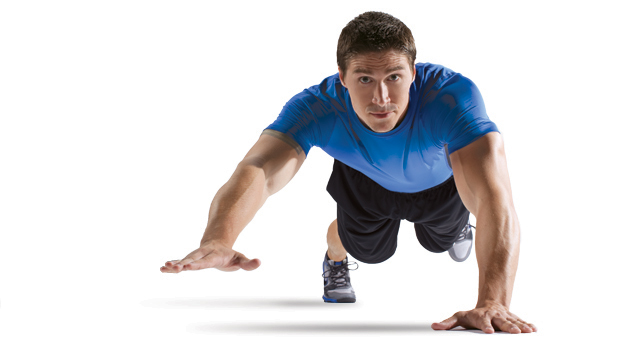
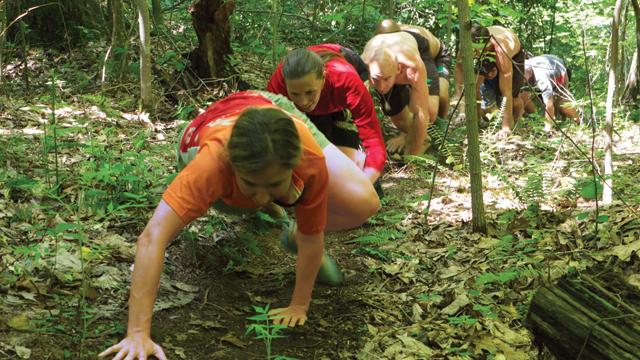

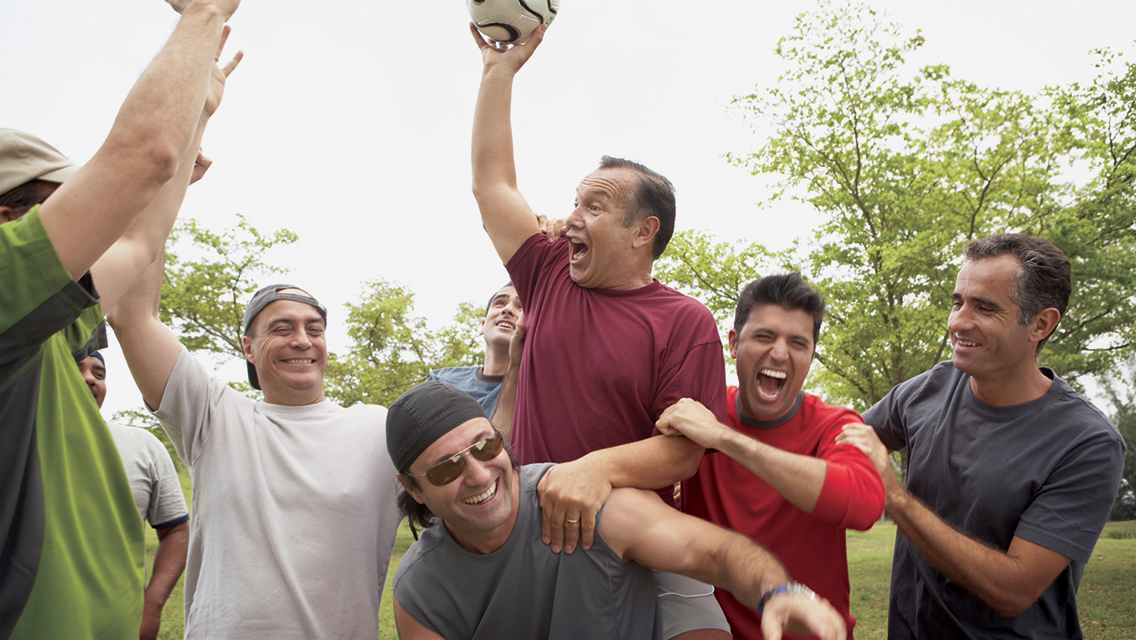
This Post Has 0 Comments